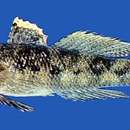Diagnostic Description
provided by Fishbase
Characterized further by pale yellowish brown color with large, irregular dark brown blotches on body; small, pale blue spots (one per scale) in longitudinal rows on body; dorsal and caudal fins with small blue spots, outer edge of dorsal fins broadly yellow; upper three pectoral rays partly free of membrane; rounded caudal fin; longitudinal scale series 29-36; predorsal scales 10-19, reaching from above middle of preopercle nearly to interorbital space; cheek and opercle without scales; ctenoid body scales, becoming cycloid on abdomen, breast and nape; depressed head, width greater than depth; depth of body 4.4-5.0 in SL (Ref. 90102).
- Recorder
- Cristina V. Garilao
Life Cycle
provided by Fishbase
Benthic spawner. Also Ref. 32023.
Migration
provided by Fishbase
Amphidromous. Refers to fishes that regularly migrate between freshwater and the sea (in both directions), but not for the purpose of breeding, as in anadromous and catadromous species. Sub-division of diadromous. Migrations should be cyclical and predictable and cover more than 100 km.Characteristic elements in amphidromy are: reproduction in fresh water, passage to sea by newly hatched larvae, a period of feeding and growing at sea usually a few months long, return to fresh water of well-grown juveniles, a further period of feeding and growing in fresh water, followed by reproduction there (Ref. 82692).
- Recorder
- Estelita Emily Capuli
Morphology
provided by Fishbase
Dorsal spines (total): 7; Dorsal soft rays (total): 9; Analspines: 1; Analsoft rays: 8
- Recorder
- Cristina V. Garilao
Biology
provided by Fishbase
Inhabits shallow rocky areas, often in pools of the intertidal zone (Ref. 2798). Occurs mostly in coastal areas. Also found in estuaries, tidal zones and often ascending into freshwater streams; smaller species live between branches of corals where they exploit several crustacean groups. Feeds on crustaceans, fish and algae (Ref. 92840). Sometimes seen as fresh catches at markets (Ref. 12693).
- Recorder
- Estelita Emily Capuli
Importance
provided by Fishbase
fisheries: minor commercial; price category: very high; price reliability: very questionable: based on ex-vessel price for species in this family
- Recorder
- Estelita Emily Capuli
分布
provided by The Fish Database of Taiwan
分布於印度-太平洋區海域,由紅海南至莫三比克的 Bazaruto
群島,東至列島群島與土木土島,北至臺灣、南韓與日本,南至大堡礁的南方。
臺灣各地岩礁區可發現。
利用
provided by The Fish Database of Taiwan
小型魚類,不具漁業價值。
描述
provided by The Fish Database of Taiwan
體延長,前部分呈圓筒形,後部側扁。背緣與腹緣平直。頭長為體長的1/3倍。眼居上側位,眼徑大於眼間距。吻圓鈍,吻長大於眼徑。口斜裂,上頜、下頜約等長,口裂延伸至眼前緣的下方。鰓蓋骨上方有3個感覺孔(H',
K', L')其中H',
K'兩孔相分離。胸鰭圓扇形,胸鰭上部分有4~5根游離鰭條;腹鰭呈吸盤狀,膜蓋中央凹入,無突起;臀鰭與第2背鰭同形,臀鰭基底長小於第2背鰭基底長;尾鰭呈圓形。新鮮魚體的體色與斑紋變異極大,一般為淡褐色或棕褐色,頭部灰棕色,體側和項部具5~6條灰褐色橫帶或具不規則的橫帶與縱帶交錯的雲斑紋;頭、體具亮藍色的小點或體部的小點一鱗片排列成縱紋狀。第一背鰭灰色,具2~3行深色縱帶,邊緣為黃色;第二背鰭淺棕色,具4~5縱行小藍點,邊緣深黃色;臀鰭與腹鰭為深黑色;胸鰭棕色,具4~5橫行的黃色小點;尾鰭淺黃色,具4~5橫行藍色或紫色相間排列的小點,下葉1/3處呈灰黑色。(林上智、林沛立編寫
2012/10)
棲地
provided by The Fish Database of Taiwan
暖水性沿岸淺水小型底層魚類,常棲息於潮間帶礫石、海灘及珊瑚叢中的海域。雜食性,以藻類、小魚及底棲無脊椎動物為食。
Bathygobius fuscus
provided by wikipedia EN
The dusky frillgoby (Bathygobius fuscus), also known as the brown frillfin,[1] is a species of goby which is found in the Indo-Pacific region from the South Africa north to the Red Sea and east as far as Tonga, south to Australia and north to Japan. It is a mainly coastal speciesbut it has an amphidromous life cycle and it occurs in estuaries and will move into in freshwater streams. In estuarine areas it is found mainly in the creeks preferring environments with sand and rubble, soft coral and open reefs. It feeds on detritus,[1] as well as feeding on crustaceans, fish and algae[2] and it is a benthic spawner. The maximum total length is 12 centimetres (4.7 in).[1]
References

- license
- cc-by-sa-3.0
- copyright
- Wikipedia authors and editors
Bathygobius fuscus: Brief Summary
provided by wikipedia EN
The dusky frillgoby (Bathygobius fuscus), also known as the brown frillfin, is a species of goby which is found in the Indo-Pacific region from the South Africa north to the Red Sea and east as far as Tonga, south to Australia and north to Japan. It is a mainly coastal speciesbut it has an amphidromous life cycle and it occurs in estuaries and will move into in freshwater streams. In estuarine areas it is found mainly in the creeks preferring environments with sand and rubble, soft coral and open reefs. It feeds on detritus, as well as feeding on crustaceans, fish and algae and it is a benthic spawner. The maximum total length is 12 centimetres (4.7 in).
- license
- cc-by-sa-3.0
- copyright
- Wikipedia authors and editors
Description
provided by World Register of Marine Species
Inhabits shallow rocky areas, often in pools of the intertidal zone.
Froese, R. & D. Pauly (Editors). (2023). FishBase. World Wide Web electronic publication. version (02/2023).
- license
- cc-by-4.0
- copyright
- WoRMS Editorial Board

